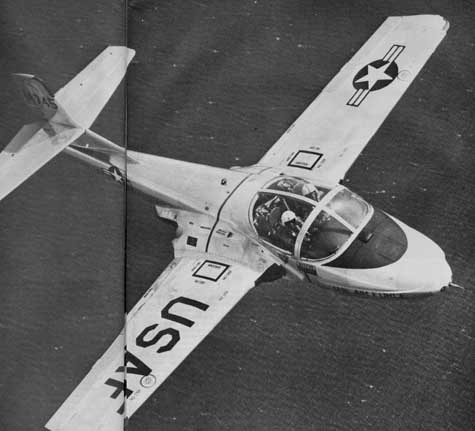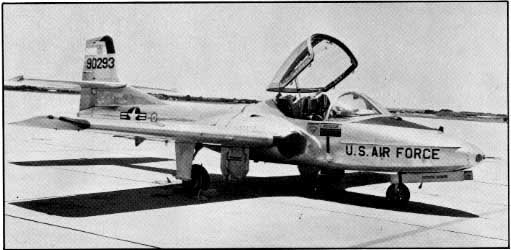

Considering that I was a small town kid, brought up during the hey-day of fighter development, the '50's, I somehow wound up with different tastes than all my peers. While the rest of the neighborhood kids were gluing photos of F-lOOs and F-15's on their walls, I was busy ferreting out 8 x lOs of Hawk 75s or CW-21s. I still carry that same perversion... I just don't like jets. I can't get starry-eyed over F-14s or Phantoms. Somehow, I just don't seem to be able to identify with them. I put them in the same category as Gemini Capsules and Titan II's. They belong to another age, another way of thinking, another era of technology. And then there's the T-37. Cessna's little dolphin nosed bird with the barn door wings has been tugging at my heart strings ever since I watched my first one grease it on somewhere in South Texas. The T-37 seems to be a combination of lines and numbers my archaic mind can handle. It looks like something the average rich guy could own and the average pilot could fly. Besides that, the T-37 gives the feeling that it "flies" rather than being propelled by an overbearing bottle of thrust and flame. It's an innocuous, unglamorous little toad, at best, but it still has a case of the tailpipe cutes that endears it to me, if nobody else. Currently, the T-37 is the bottom rung of the USAF's training ladder. After a few hours in a T-41 (hopped up C-172) to eliminate the barf bag specialists, the USAF pops their boys right into the T-37 and makes them into jet pilots. They've been doing it that way for a long time, a hell of a long time. The T-37 first flew in 1954 and Cessna is still cranking them out today, a fact that tends to go unnoticed in an age that is seeing the F-4 already relegated to National Guard and static display duties. It's been around such a long time that logic says that sooner or later bits and pieces of less fortunate T-37s are going to begin showing up in scrap and surplus yards. When that happens, the same thing that hap-pened to T-34s is going to come about. Somebody somewhere is going to start putting them together as toys for well heeled boys. Look what is happening to F-86s and T-33s. The precedent has been set, so even the mountain of certification obstacles certain to be part of the FAA's game plan will eventually be scaled. You can't keep a good plane down. But is the T-37 a good plane? It must be or the USAF wouldn't be so committed to it. There was an obvious way to answer that question, so I exercised my prerogative as a tax-paying aviation journalist and went wrangling my way into a training command T-37. At first my requests were met with a certain amount of question. "Are you sure you mean T-37 and not T-38, our new hot one?" No, I wanted the -37. The next question was usually short. "Why?" The T-37 is apparently nowhere near the top of the list of airplanes used for impressing civilian types on PR flights.

The T-37 is in inventory only at those training command fields used specifically for primary training, which means, if you want to fly a Tweety Bird, you have to do it with a little southwestern sand in your teeth. And so it was that I found myself in Enid, Oklahoma at Vance Air Force Base. As a normal rule I feel intensely uncomfortable on military bases...something to do with having come of age in the middle of the anti-military environment of the mid-sixties. However in the new Air Force, and especially at Vance, I didn't get the usual feeling of super-starched military regimentation. For one thing, I didn't see one single crew cut on anybody below the rank of major and every third top lip sprouted a mustache. Another thing contributing to Vance's more relaxed posture is the fact that it is staffed and operated almost entirely by civilians. The only function of the base is to teach flying, so the only military personnel on base are directly involved with the operational aspects of the flight line and base administration. Otherwise, all the support functions, even the aircraft maintenance, are done by civilian contractors. The ground crews are not only civilians, but some of the local girls have signed on, perhaps in hopes of catching a Captain. So the guy giving you the thumbs up signal for taxi might be one of the cutest crew chiefs you've ever seen. After a morning spent learning how to eject, climb and otherwise claw my way out of a disabled T-37 in the air or on the ground, I reported to the flight operations office and met the IP (instructor pilot) who was going to show me what the T-37 was all about. Again I was pleasantly surprised. Captam Ron Smith was far from being the ultra-military type I had expected. Captain Ron turned out to be my kind of people... an airplane freak through and through. Who else would spend all day screaming around the sky at the taxpayers' expense and then go home to rub and polish on his own C-172? A few minutes was spent in the equipment room getting a flight suit and parachute as well as going through an elaborate fitting exercise aimed at equipping me with the most uncomfortable oxygen mask and helmet they had available. Then it was out to the flight line. I felt just a bit conspicuous in my super-genuine USAF flight gear with my much longer than GI locks flapping in the wind. Oh well, it just helped tone down my fighter pilot swagger a bit. One additional piece of gear necessary for working around T-37s is a set of ear muffs. They don't call the T-37 a six thousand pound dog whistle for nothing! The little J-69 engine is of the old centrifugal flow design, rather than being axial flow, which means it is really nothing but a kerosene burning siren. The noise generated by one T-37 is unreal, but at Vance there were around 65 of them lined up. The prairie dogs for miles around must spend most of their time with their little fingers in their ears. Walking up to the Tweety Bird confirmed my earliest recollections; it's the perfect size airplane for two people and a couple of jets. It is barely waist high at the canopy rails and Captain Smith repeated the usual Air Force joke, which can't be repeated in its entirety here. It has to do with the -37 being the only USAF airplane you can stand on the ground and do something obscene into the cockpit. |